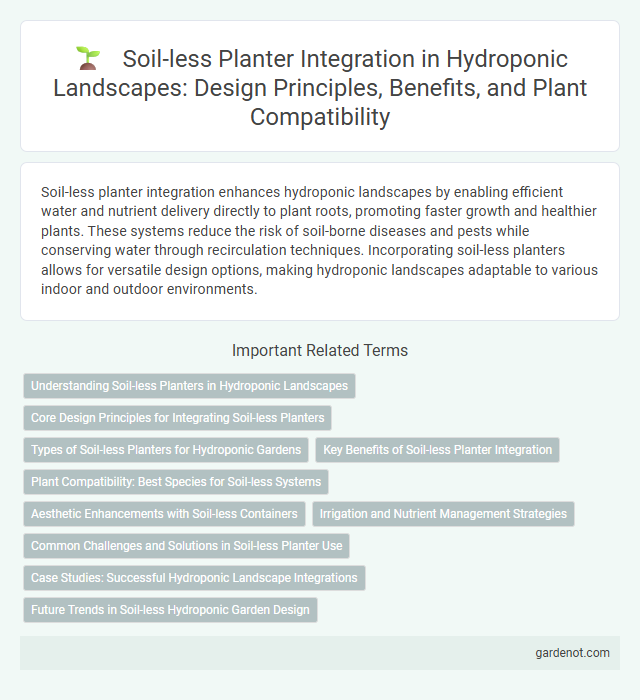Soil-less planter integration enhances hydroponic landscapes by enabling efficient water and nutrient delivery directly to plant roots, promoting faster growth and healthier plants. These systems reduce the risk of soil-borne diseases and pests while conserving water through recirculation techniques. Incorporating soil-less planters allows for versatile design options, making hydroponic landscapes adaptable to various indoor and outdoor environments.
Understanding Soil-less Planters in Hydroponic Landscapes
Soil-less planters in hydroponic landscapes enable nutrient delivery directly to plant roots through water-based systems, enhancing growth efficiency and resource use. These planters utilize inert growing media such as coco coir, perlite, or rockwool to support root structures without soil. Integrating soil-less planters reduces disease risk associated with soil, promotes cleaner urban agriculture, and supports sustainable landscape designs.
Core Design Principles for Integrating Soil-less Planters
Core design principles for integrating soil-less planters in hydroponic landscapes emphasize efficient nutrient delivery systems that ensure optimal plant growth by maintaining precise water and nutrient balance. Structural stability and modularity are prioritized to accommodate various plant types and facilitate easy maintenance while maximizing space utilization. Environmental factors such as light exposure, airflow, and temperature regulation are carefully managed to create ideal growth conditions within soil-less planter setups.
Types of Soil-less Planters for Hydroponic Gardens
Soil-less planters for hydroponic gardens include nutrient film technique (NFT) channels, deep water culture (DWC) tubs, and aeroponic misters, each designed to optimize water and nutrient delivery without soil. Wick systems use capillary action to draw nutrient solutions to plant roots, ideal for small-scale or beginner setups. Ebb and flow trays periodically flood plant roots with nutrient solutions, providing oxygenation and growth support for various crops.
Key Benefits of Soil-less Planter Integration
Soil-less planter integration in hydroponic landscapes maximizes space efficiency and promotes faster plant growth by delivering nutrients directly to roots, eliminating soil-borne diseases. This method reduces water usage by up to 90% compared to traditional soil gardening and enhances crop yields through precise nutrient control. Enhanced aeration and root oxygenation further improve plant health and resilience, making soil-less systems ideal for urban and indoor farming environments.
Plant Compatibility: Best Species for Soil-less Systems
Lettuce, spinach, and herbs such as basil and mint thrive exceptionally well in soil-less planter integrations due to their rapid growth and minimal nutrient requirements. Tomatoes and strawberries are also highly compatible with hydroponic systems, benefiting from precise nutrient delivery and controlled environments. Selecting species with high water and nutrient uptake efficiency maximizes yield and sustainability in soil-less landscapes.
Aesthetic Enhancements with Soil-less Containers
Soil-less planter integration in hydroponic landscapes offers sleek, modern containers that enhance visual appeal while promoting clean, efficient plant growth. These containers come in various materials and designs, allowing for customizable aesthetic enhancements that blend seamlessly with indoor and outdoor environments. Their minimalist structure reduces clutter and emphasizes plant vibrancy, elevating overall landscape beauty.
Irrigation and Nutrient Management Strategies
Soil-less planter integration in hydroponic landscapes relies on precise irrigation systems that deliver nutrient-rich water directly to plant roots, optimizing growth while conserving resources. Advanced nutrient management strategies utilize automated dosing pumps and real-time sensors to maintain ideal pH and electrical conductivity (EC) levels, ensuring balanced nutrient availability. This approach minimizes runoff and enhances plant health by providing consistent hydration and tailored nutrient profiles critical for soil-less cultivation.
Common Challenges and Solutions in Soil-less Planter Use
Soil-less planter integration in hydroponic landscapes often faces challenges such as nutrient imbalances, root rot, and inadequate oxygen supply to plant roots. Solutions include the use of balanced nutrient solutions tailored for hydroponics, implementing effective drainage and aeration systems, and regularly monitoring pH and electrical conductivity levels. Advances in substrate materials like coconut coir and perlite improve water retention and aeration, reducing common issues in hydroponic soil-less planters.
Case Studies: Successful Hydroponic Landscape Integrations
Case studies on soil-less planter integration in hydroponic landscapes reveal significant improvements in water efficiency and plant growth rates, with systems achieving up to 90% water savings compared to traditional soil-based methods. Urban projects like Singapore's Gardens by the Bay demonstrate successful large-scale implementation, combining aesthetic design with sustainable resource management. Data from these case studies highlight increased crop yields and reduced nutrient runoff, validating soil-less planters as key components in modern hydroponic landscape design.
Future Trends in Soil-less Hydroponic Garden Design
Future trends in soil-less hydroponic garden design emphasize smart planter integration with built-in sensors for real-time monitoring of nutrient levels, pH balance, and moisture content. Advanced materials such as biodegradable composites and self-regulating substrates enhance sustainability and plant health. Modular, customizable systems enable scalable urban gardening solutions tailored to diverse environments and crop types.
Soil-less planter integration Infographic

 gardenot.com
gardenot.com